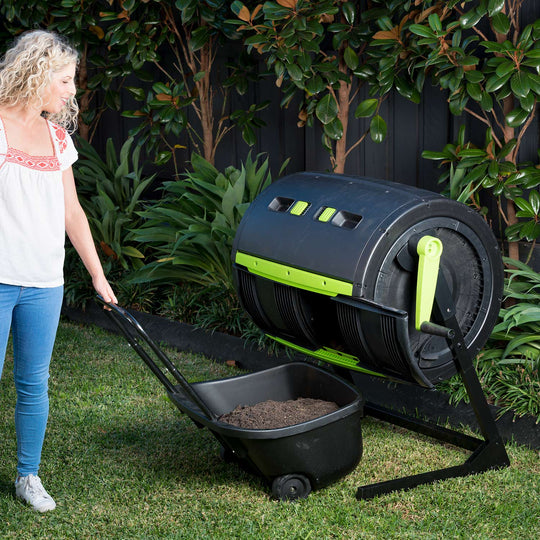COMPOST TUMBLERS
Gardening can never be more sustainable and fun.
LET’S GET READY TO TUMBLE!
Composting practices are thousands of years old and it’s difficult to say when the first tumblers were used. In the 1970s when the back-to-the-land movement was really taking off, a few innovative gardeners offered plans for barrels, “compost rollers” and other schemes for containing and turning compost. Commercial tumblers have been available for decades and the choices available have mushroomed over the last several years. Plans for making your own tumbler are also numerous. The commercial tumblers are mostly of two types: horizontal and vertical. Variations include spherical tumblers made to roll along the ground or contained on stands. Sizes vary from large bins capable of holding bushels of yard waste to smaller barrels designed for back porch use. The simplest designs are basically rotating barrels. Some horizontal tumblers have cranks to facilitate turning. All are vented to allow in fresh air to fuel the composting process. More sophisticated models use piping to bring oxygen to the centre of the barrel and paddles inside the barrel to help mix and aerate the composting materials when turned.
Takes in different materials, from grass clippings to sappy material.
Compost output is faster because of the tumbler's ability to heat up the material in it.
Aeration through tumbler perforations resulting in no unpleasant smells.
Children can even get involve in the process because of its usability.
Helps in the fight against vermin on your yard.
Ease to operate.
Great conversation starter - with people wanting to know how well it is doing.
How do compost tumblers work? Simple. You load them with green and brown waste from your yard and kitchen. When full, you give them time to work, in other words, heat up. Turning a compost pile — mixing the organic materials and the organisms it contains with heat-producing oxygen — is the traditional method of keeping the process going full steam. A tumbler does this more simply than the old strong-back-and-garden-fork method. By turning the tumbler, the organic materials are mixed and infused with fresh oxygen. When a check reveals the compost is complete — and this can happen in a matter of weeks — the same access that allowed you to fill the tumbler lets you empty it.

Watch this video to see how the 245L Maze Compost Tumbler works.
TURN! TURN! TURN!
How you turn your compost also has an effect. Swing it back-and-forth several times after each spin to shake up the materials then spin it again. The axle on which the barrel rotates goes through the centre of your tumbler and help breaks up the compostable material as it’s turned. This should be done a minimum of twice a week and three or four times a week isn’t too much. While it doesn’t take long for heat to build inside a properly filled tumbler, too much tumbling dissipates heat and defeats the purpose. At their most efficient, compost tumblers and bins can generate temperatures as high as 200 degrees. Naturally, you’ll want to position your tumbler strategically so that the finished product is unloaded close to where it will be used.

“I am afraid of rats, I hope this does not attract them.”
As an afterthought, do not add any cooked food or meat to the compost tumbler as this will attract vermin (rats). Composting works better in hot weather than cold, but it’s amazing how much heat can be generated inside even in the winter – if there is enough compost in the drum. Ideally, buy two of these, so when one is full, then you can start filling the other, and when the full one is fully composted, you can either bag it up for later use or put it straight on the garden. I hope this helps for those that know little about gardening.
Build Your Dream Garden Hassle Free!
The compost tumbler that has constantly been on display in this website is the one we recommend for everyone, beginners and experts alike. Start composting using the Maze 245 Litre Compost Tumbler which only goes for £184.99.

